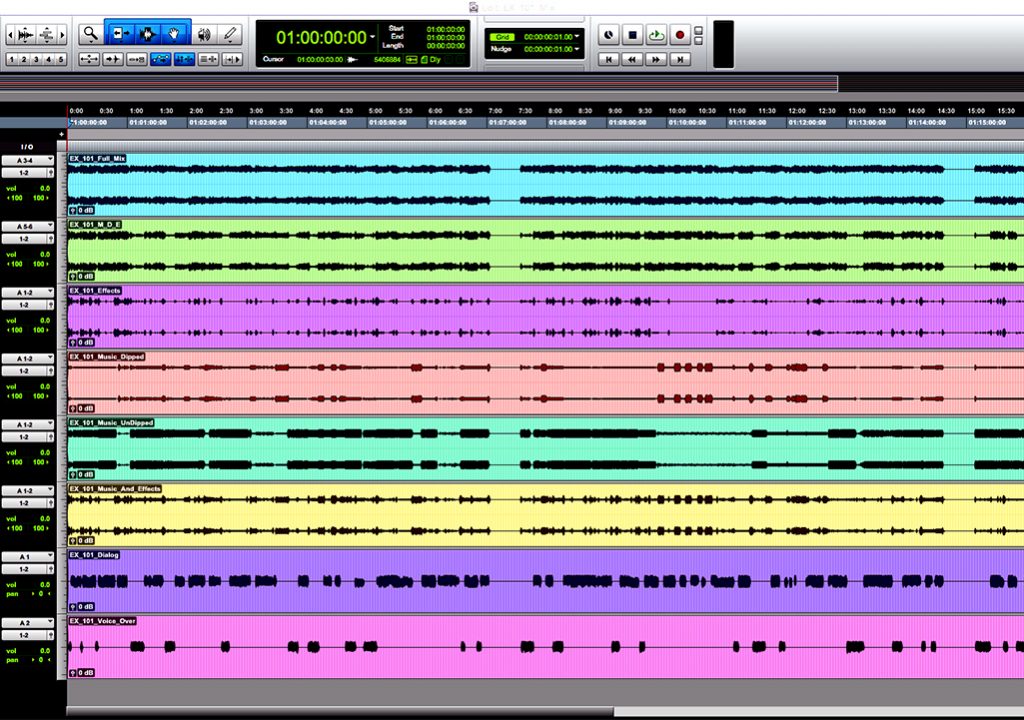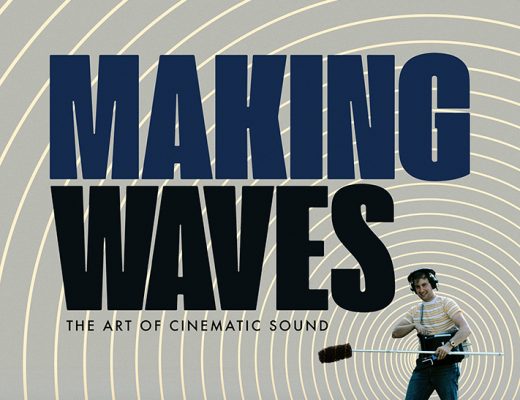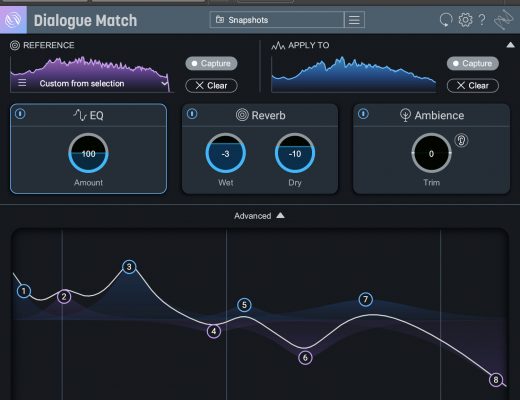
Editor’s Note: “28 Weeks of Post Audio” originally ran over the course of 28 weeks starting in November of 2016. Given the renewed focus on the importance of audio for productions of all types, PVC has decided to republish it as a daily series this month along with a new entry from Woody at the end. You can check out the entire series here, and also use the #MixingMondays hashtag to send us feedback about some brand new audio content.
Stems, stem-outs, splits or split tracks can be defined as the elements that make up the final full mix of a soundtrack. There really is no such thing as a “standard” set of audio splits, but there are typical variations and a number of very useful ones. I have a separate post with a different take on this subject here. Creating these sub-mixes are key for the future life of any content.
Depending on the length and complexity of a project, I may have a couple of hundred tracks of audio at any given moment. And this is from a process, typically called pre-dubbing, of paring things down over time to get to final mixing. With the advent of DAWs (digital audio workstations) pre-dubs have changed a lot. Nowadays, sometimes we can even essentially go without the pre-dubs, in the creation of the final mix.
If this is a project with distribution or with broadcast requirements, then a number of stems or splits will already be designated in some sort of delivery document, specifying the stems required for delivery. If you do not have a delivery requirement at the time of the final mix down, it is nonetheless imperative that some sort of splits be created at the final outputs. All of the stems created at that time may not be sufficient for a later deal, but if thought out smartly, at least most of the splits will be properly complete.
A full mix (the final soundtrack of a movie or television program), can come in a variety of multi-channel formats – stereo, surround 5.1, or 7.1, and Dolby Atmos, a system that changes channel based mixes to object based mixes and fold downs. Mono will be typically required as well. The idea of a split or a stem is to break an element out from the full mix. As discussed in prior posts, the main aspects of a soundtrack are; the dialog elements, the music elements and the sound effects elements. By splitting out variations of these elements, then later, when making picture changes or edit alterations, it is possible to reedit the show without going back to audio post.
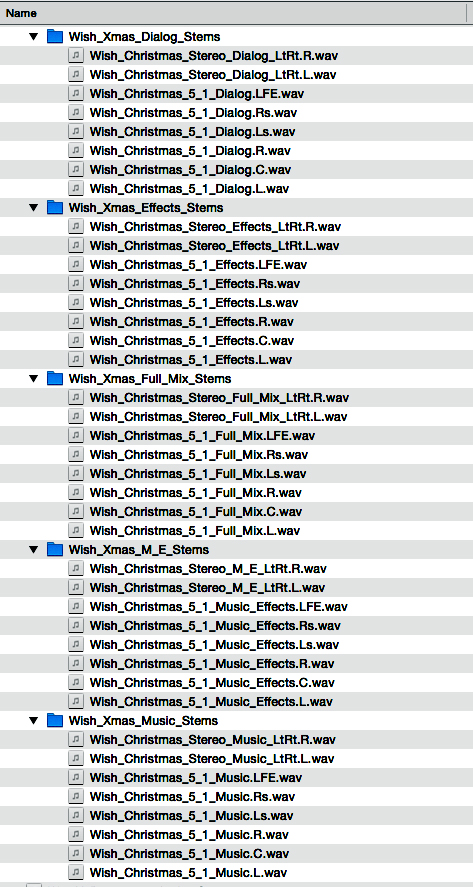
Some of the typical splits of a full mix are dialog only, music only, sound effects only and a track of the sound effects and the music blended together, typically referred to as the M & E (music and effects). These splits are sometimes mono, sometimes stereo and sometimes surround, but often, requirements call for all of the above – mono dialog, stereo dialog, surround dialog, mono M&E, stereo M&E, surround M&E and so on.
Also due to the various audio restrictions on television, most shows will want a mix that will work within TV specs, and deliveries can require a censored full mix and an uncensored full mix, require censored split tracks and uncensored split tracks.
There are deliveries that require the full mix minus the voice over or the narrator. These stems are typically referred to as the “mix minus.” There are deliveries that require “undipped stems.” An undipped stem is a stem of the full mix that does not have the volume rides on it from the mix to allow for the dialog, but is rather a straight recording all of the music. An undipped music stem is the entire music of the piece, in complete sync with the picture but with the tracks playing full. For instance, if there is a volume dip in the music while a character is speaking on-screen, that volume dip is not reflected in the undip but rather remains at the same volume throughout.
Undipped stems are useful for later repurposing of a program. It is basically an unmixed pre-dub of all of the main elements – dialog, music and effects, in complete sync with the locked picture that can be remixed by someone else for other purposes. Undipped stems are generally for foreign language remixes where the dialog track is replaced by various voices in other languages.
Having proper stems prepared, even if your project is not destined for immediate delivery and distribution is an invaluable practice. A final full mixed film will also inherently have all of the properly mixed elements. If the location recordings had pops and ticks and was nicely noise reduced, de-clicked and edited and mixed in audio post, then the resulting dialog only stem, split out from that mix, will be clean, properly balanced and EQ’d and free from artifacts.
This dialog only stem can be very important for other purposes for the project. If the film is making its way around the film festival circuit, the time will come for a teaser or trailer to be made. Typically, a trailer won’t be made from the final mix of the program. The dialog only stem is a mastered mix that won’t have sound effects and music. It will allow for clean and precise audio edits and be a final, mastered audio track to work from. Cutting a trailer with a full mix only is problematic, since it will have the music and effects tied to it, making clean edits difficult, if not impossible. The sound effects stem can be cut in with the chosen trailer footage, and music from the music only stem can complete the final trailer edit.
The music and effects, or M&E stem is a requirement for international delivery. Although today audiences are more used to reading text on-screen, many if not all territories will still dub the actors in another language. Music and effects stems are a mastered split of the whole mix with no dialog or narration. Language dub houses then rerecord the dialog or narration in French, Spanish, Italian, German and more. We’ve all seen awesome examples of foreign language movies dubbed into English or re-voiced for censorship! This is how they get it done.
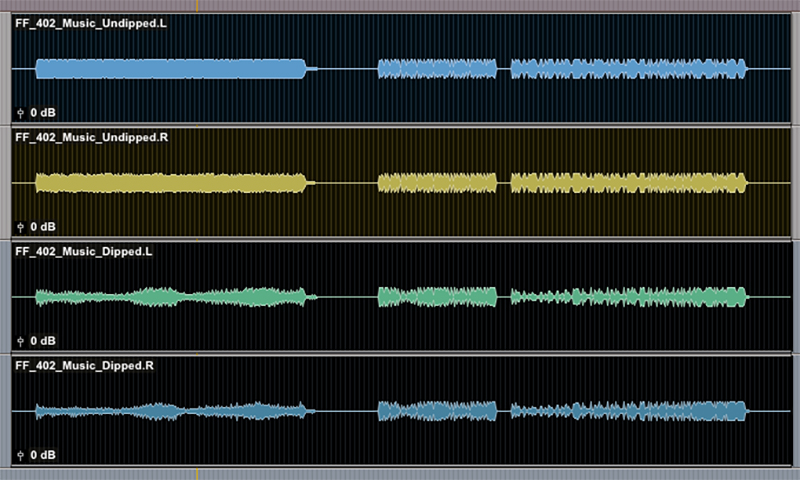
At the end of the day filmmakers want a sale to get their work in front of an audience and use the funds to make a living and to make more films. Sometimes that selling process takes many months or even years, long after the mixing sessions are complete. When these projects do get the sale, if these stems have already been properly prepared, the filmmaker may already have what they need.
There are many variations of mix splits that can be requested. For instance, as mentioned, censored and uncensored versions of the full mix and of the dialog or narration tracks. If there are film clips or celebrities or notables, or perhaps music that has not been properly cleared, any of that should be split out from the final mix. This allows for simple re-editing and for easy re-purposing later. Each audio delivery is unique; the particulars of the project will dictate the best course of action. The experience and expertise of the mixer should be able to guide the filmmaker to a useful set of stems specific to their project.
Sound editing and mixing is a very labor intensive and time consuming art, requiring the skills of many different artists – dialog editors, effects editors, sound designers, music editors and rerecording mixers and more. All of the sound labors of a project get their final expression in the full mix. With the dedicated work of the sound team and the vision of the filmmaker, the final choices are all reflected in the final full mix.
Splitting those discrete variations of dialog, music and effects out from the full mix offers fully mastered elements. All of the dialog tracks, sound effects tracks and music tracks, all of manipulations and processing with EQ, reverbs and compressors, the masterful, blended mix from post audio will be distilled into these discrete, final sub-mixes. It doesn’t matter if the project is destined for a 2000 screen US release or it is short film that was made as a labor of love, creating stems at the time of the mix is an essential practice in sound for film. Even if your project does not have distribution or a pending sale, be sure to talk with your post sound team to prepare the final sound elements for archiving and its eventual sale into the marketplace.
This series, 28 Weeks of Audio, is dedicated to discussing various aspects of post production audio using the hashtag #MixingMondays. You can check out the entire series here.
Woody Woodhall is a supervising sound editor and rerecording mixer and a Founder of Los Angeles Post Production Group. You can follow him on twitter at @Woody_Woodhall
![]()

Filmtools
Filmmakers go-to destination for pre-production, production & post production equipment!
Shop Now